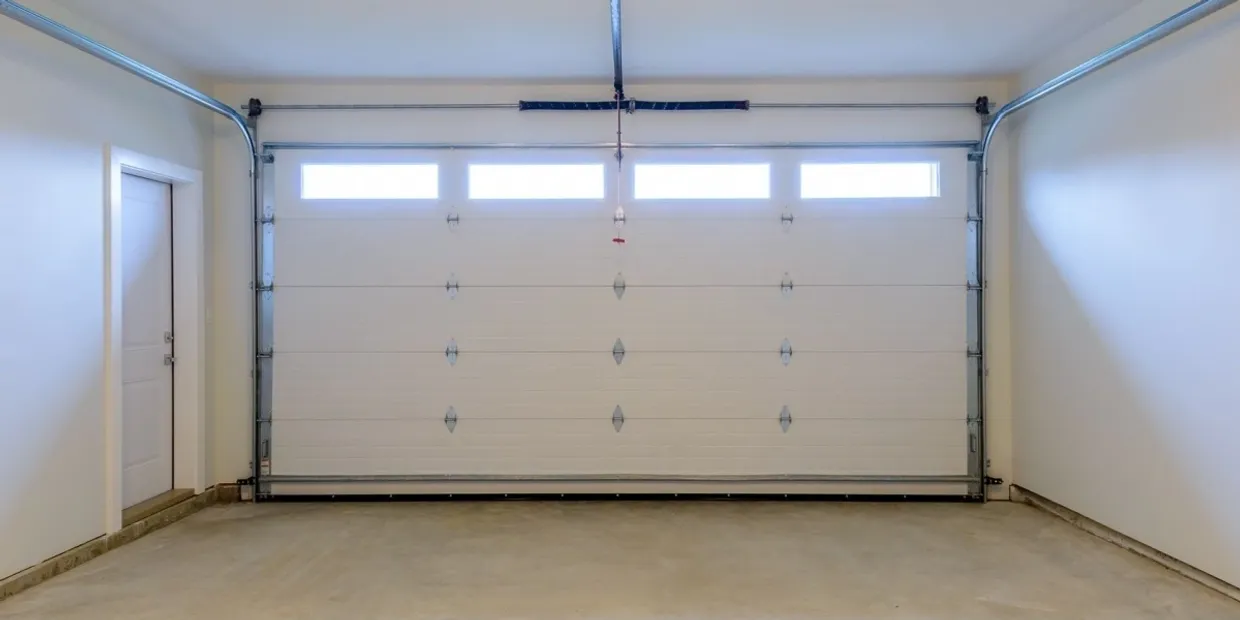When selecting a new garage door, one key decision is whether to choose an insulated or non-insulated door.
Each option has its own advantages and drawbacks based on your needs and preferences.
In this article, we’ll explain the differences between insulated and non-insulated garage doors, explore their pros and cons, and help you determine which one is the best fit for your home.
Should I get an insulated or non-insulated garage door?
An insulated garage door helps regulate temperature, reduces noise, and boosts energy efficiency, making it ideal for garages used as living spaces or in extreme climates. If you’re dealing with garage door issues at any hour, professional 24/7 garage door repair in Morris, Illinois ensures your insulated system continues performing at its best without interruption.
Key Takeaways
- Insulated garage doors provide better energy efficiency, noise reduction, and temperature control.
- Non-insulated doors are more affordable and still offer basic protection against the elements.
- The decision largely depends on your climate, garage use, and budget.
What Is an Insulated Garage Door?

Insulated garage doors are designed with a layer of insulation material between the inner and outer layers of the door.
This insulation helps to reduce heat transfer, keeping the garage cooler in the summer and warmer in the winter.
There are several types of insulation used in garage doors, including polystyrene and polyurethane, both of which offer different levels of thermal efficiency.
When it comes to selecting a new garage door, one of the most important decisions is whether to go with an insulated or non-insulated door.
Both types have their advantages and drawbacks, depending on your specific needs and preferences.
We will break down the differences between insulated and non-insulated garage doors, explore the pros and cons of each, and help you determine which one is the best fit for your home, especially if you’re considering the best garage door insulation for home for better comfort and efficiency.
1. Advantages of Insulated Garage Doors
Energy Efficiency: The main benefit of an insulated garage door is its ability to improve energy efficiency. By keeping the garage temperature more stable, you can reduce the load on your HVAC system, saving money on heating and cooling costs.
Better Temperature Control: Insulated doors help maintain a more comfortable temperature inside your garage. This is especially important if you use your garage as a workshop, gym, or living space.
Noise Reduction: Insulated doors also help to reduce noise, making them a great option if you live in a busy area or have a home office adjacent to the garage.
Durability: Insulated doors tend to be stronger and more durable than non-insulated ones. The insulation adds an extra layer of protection, making the door less likely to dent or get damaged.
2. Disadvantages of Insulated Garage Doors
Higher Cost: The main downside of insulated garage doors is their higher upfront cost. They are typically more expensive than non-insulated doors, both in terms of purchase price and installation.
Heavier Weight: Insulated doors tend to be heavier, which may require more effort for the garage door opener to lift. This could lead to extra wear and tear on the opener over time.
What Is a Non-Insulated Garage Door?

Non-insulated garage doors are typically made from a single layer of metal or other materials without any insulating layer.
These doors are often used in areas where temperature extremes aren’t as much of a concern, or where a homeowner is looking for a more budget-friendly option.
1. Advantages of Non-Insulated Garage Doors
Affordability: One of the biggest advantages of non-insulated doors is their lower cost. Without the insulation layer, these doors are typically much cheaper than their insulated counterparts.
Lighter Weight: Non-insulated doors are lighter than insulated doors, which can put less strain on the garage door opener and other components.
Simple Design: Non-insulated doors are available in a wide variety of styles and materials, making it easy to find an option that suits your aesthetic preferences.
2. Disadvantages of Non-Insulated Garage Doors
Poorer Temperature Control: Non-insulated doors offer little protection from extreme temperatures. If you live in an area with harsh winters or hot summers, your garage can become very uncomfortable without insulation.
Higher Energy Bills: Without the added insulation, non-insulated doors allow heat to escape in the winter and enter in the summer, which can result in higher heating and cooling costs for your home.
Increased Noise: Non-insulated doors tend to be noisier when they open and close, as there’s no sound-dampening layer between the door’s inner and outer layers.
Insulated vs. Non-Insulated Garage Doors: Which One Is Right for You?
When deciding between an insulated and non-insulated garage door, several factors should be taken into account.
The type of door you choose should align with your specific needs, climate, and budget.
1. Climate Considerations
If you live in an area with extreme temperatures—such as the cold winters in places like Chicago or the hot summers in Arizona—an insulated garage door can make a significant difference in maintaining a comfortable environment.
Insulation helps regulate the temperature inside your garage, making it more comfortable and reducing energy costs.
On the other hand, if you live in a milder climate, where temperatures don’t fluctuate drastically, a non-insulated door might be sufficient.
Non-insulated doors are typically fine for areas where the garage is not used as a living or working space.
2. Garage Use
Think about how you use your garage. If your garage is primarily a place to park your car, a non-insulated door may work just fine.
However, if you use your garage as a workshop, office, gym, or additional living space, an insulated door will provide greater comfort and energy efficiency.
3. Budget
If cost is a significant factor in your decision, a non-insulated garage door may be the better choice.
These doors are generally more affordable, both in terms of purchase price and installation.
However, keep in mind that the potential long-term savings on energy bills could make an insulated door a better investment if you plan to use your garage frequently.
4. Noise Sensitivity
If noise is a concern, an insulated garage door is a better choice. The insulation helps reduce noise, both from outside and from the door’s operation.
If you live in a noisy neighbourhood or have a garage adjacent to a bedroom, the quieter operation of an insulated door may be a valuable feature.
How Much Does an Insulated Garage Door Cost?

The cost of an insulated garage door varies depending on the material, insulation type, and size.
On average, insulated garage doors can cost between $600 and $2,500, depending on the quality and style of the door.
Steel Insulated Doors: These are typically the most affordable type of insulated door, with prices ranging from $800 to $1,500 for a standard 16×7 door.
Wooden Insulated Doors: Wooden doors are more expensive, and their cost can range from $1,500 to $3,000, depending on the craftsmanship and wood type.
In contrast, non-insulated garage doors tend to be cheaper, with prices starting at around $300 for a basic steel door and going up to $1,500 for a more decorative or custom design.
When to Call a Professional
While installing a garage door may seem like a DIY project, it’s often best to call a professional for proper installation.
Garage doors are heavy and require precise alignment and balance to function correctly.
A professional will ensure that your door operates safely and smoothly, whether it’s insulated or non-insulated.
Frequently Asked Questions
1. Can I install an insulated garage door myself?
While it’s possible to install an insulated garage door yourself, it’s recommended to hire a professional to ensure proper installation and safety.
2. Will an insulated garage door reduce my energy bills?
Yes, an insulated garage door helps to regulate the temperature in your garage, which can reduce heating and cooling costs for your home.
3. How long do insulated garage doors last?
Insulated garage doors can last up to 20 years or more with proper maintenance, especially if they are made from durable materials like steel or composite.
Conclusion
Choosing between an insulated and non-insulated garage door comes down to your specific needs and budget.
If you want better energy efficiency, noise reduction, and a more comfortable environment, an insulated garage door is a great investment.
However, if you’re on a tight budget and don’t need the added benefits of insulation, a non-insulated door may be a more cost-effective choice.
Whatever option you choose, it’s important to maintain your garage door and ensure it’s properly installed to keep it functioning smoothly for years to come.

